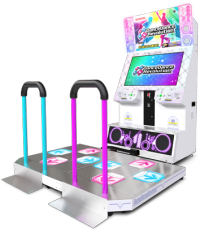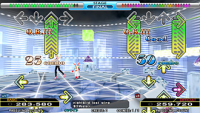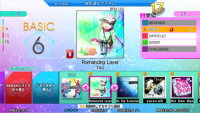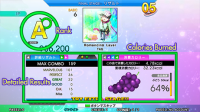What Is DDR?: Difference between revisions
m (→External Links: added category.) |
No edit summary |
||
| Line 1: | Line 1: | ||
= DanceDanceRevolution = | = DanceDanceRevolution = | ||
'''DanceDanceRevolution''' (ダンスダンスレボリューション), abbreviated '''DDR''' and also known as '''Dancing Stage''' (ダンシングステージ) in select games and territories, is the second music video game series produced by KONAMI in the [[BEMANI]] series in 1998. It started initially as an arcade-only game but since received both home versions ( | '''DanceDanceRevolution''' (ダンスダンスレボリューション), abbreviated '''DDR''' and also known as '''Dancing Stage''' (ダンシングステージ) in select games and territories, is the second music video game series produced by KONAMI in the [[BEMANI]] series in 1998. It started initially as an arcade-only game but since received both home versions (ports and exclusive versions) and various spin-offs. To this day, DanceDanceRevolution is the BEMANI series with the most titles released internationally. | ||
== History == | == History == | ||
[[Image:DanceDanceRevolution logo.png|thumb|DanceDanceRevolution series logo since 2009.]] | [[Image:DanceDanceRevolution logo.png|thumb|DanceDanceRevolution series logo since 2009.]] | ||
:A timeline of the DanceDanceRevolution series can be [[DDR History|found on this page]]. | :A timeline of the DanceDanceRevolution series can be [[DDR History|found on this page]]. | ||
In the spring of 1998, [[Yoshihiko Ota]], a game producer at KCET (a former subsidiary of KONAMI) had an idea for a music game inspired by his habit of walking around town and visiting clubs and discos. He thought that moving his body along to music was fun and could be a great idea for a game. His initial idea received mostly a negative reception from his colleagues: | In the spring of 1998, [[Yoshihiko Ota]], a game producer at KCET (Konami Computer Entertainment Tokyo, a former subsidiary of KONAMI) had an idea for a music game inspired by his habit of walking around town and visiting clubs and discos. He thought that moving his body along to music was fun and could be a great idea for a game. His initial idea received mostly a negative reception from his colleagues: "It's embarrassing to dance in front of people; no one will want to do it!" He argued that the same logic could be applied to karaoke which was quite popular at that time. Ota's initial idea was for a a game operated by hand by pushing buttons to go along with the music. However, during the development of that plan, he heard about a product in development that would require the player to stand on panels and operating the game would require the player's foot. That concept mixed with his own idea inspired him to create DanceDanceRevolution. | ||
Instead of the usual one year production schedule, Ota decided to make the initial prototype in four months with a core team of 35 people. During the production of the first game, the team studied all kind of different dances and used motion capture technique to analyze the dancers' movement. The results of their research indicated that using 4 arrows for the game would be the most optimal setting. The development process went smoothly but the reception within the company was still negative. Ota believed in his concept and decided to pursue the project with a location test. The prototype was then brought to a public arcade in Japan for two days of observation. The first day wasn't successful due to the machine being put higher than the first floor. On the second day, they moved the machine and it was a real success with the customers. | Instead of the usual one year production schedule, Ota decided to make the initial prototype in four months with a core team of 35 people. During the production of the first game, the team studied all kind of different dances and used motion capture technique to analyze the dancers' movement. The results of their research indicated that using 4 arrows for the game would be the most optimal setting. The development process went smoothly but the reception within the company was still negative. Ota believed in his concept and decided to pursue the project with a location test. The prototype was then brought to a public arcade in Japan for two days of observation. The first day wasn't successful due to the machine being put higher than the first floor. On the second day, they moved the machine and it was a real success with the customers. | ||
Revision as of 01:27, 24 February 2015
DanceDanceRevolution
DanceDanceRevolution (ダンスダンスレボリューション), abbreviated DDR and also known as Dancing Stage (ダンシングステージ) in select games and territories, is the second music video game series produced by KONAMI in the BEMANI series in 1998. It started initially as an arcade-only game but since received both home versions (ports and exclusive versions) and various spin-offs. To this day, DanceDanceRevolution is the BEMANI series with the most titles released internationally.
History
- A timeline of the DanceDanceRevolution series can be found on this page.
In the spring of 1998, Yoshihiko Ota, a game producer at KCET (Konami Computer Entertainment Tokyo, a former subsidiary of KONAMI) had an idea for a music game inspired by his habit of walking around town and visiting clubs and discos. He thought that moving his body along to music was fun and could be a great idea for a game. His initial idea received mostly a negative reception from his colleagues: "It's embarrassing to dance in front of people; no one will want to do it!" He argued that the same logic could be applied to karaoke which was quite popular at that time. Ota's initial idea was for a a game operated by hand by pushing buttons to go along with the music. However, during the development of that plan, he heard about a product in development that would require the player to stand on panels and operating the game would require the player's foot. That concept mixed with his own idea inspired him to create DanceDanceRevolution.
Instead of the usual one year production schedule, Ota decided to make the initial prototype in four months with a core team of 35 people. During the production of the first game, the team studied all kind of different dances and used motion capture technique to analyze the dancers' movement. The results of their research indicated that using 4 arrows for the game would be the most optimal setting. The development process went smoothly but the reception within the company was still negative. Ota believed in his concept and decided to pursue the project with a location test. The prototype was then brought to a public arcade in Japan for two days of observation. The first day wasn't successful due to the machine being put higher than the first floor. On the second day, they moved the machine and it was a real success with the customers.
After the official release, DanceDanceRevolution became a success in Japan which led the game being released in various countries around the world. Throughout the years, DanceDanceRevolution received various spin-offs along with home versions of the game. In recent years, the game returned to be mostly an arcade only game in Asia.
Releases
- A list of all the DanceDanceRevolution releases can be found here.
Following the naming convention started with beatmania, each new DanceDanceRevolution games had the suffix MIX added after the version number. That system was kept from DanceDanceRevolution 2ndMIX until DDRMAX2 -DanceDanceRevolution 7thMIX-. The games released after that, received a unique name instead of simply the MIX number: EXTREME, then SuperNOVA and its sequel, SuperNOVA 2. To celebrate the 10th anniversary of the series, DanceDanceRevolution X was announced as the successor to SuperNOVA2 and spanned two sequels: X2 and X3 VS 2ndMIX. Since 2013, the arcade game returned to its core name DanceDanceRevolution. The 2013 version is known as DanceDanceRevolution (2013) while the current version is known as DanceDanceRevolution.
Gameplay
The goal of the game is to make points by stepping correctly on the matching arrows of the dance platform to the arrows seen on screen when they reach the STEP ZONE (ステップゾーン). The STEP ZONE is the four grey arrows (← ↓ ↑ →) that can be seen on the top of the screen, below the DANCE GAUGE.
Dance Platform
The core of the game revolves around 4 arrows placed in a cross position on a dance platform to be stepped on by the feet of the players to musical and visual cues. The spin-off, DanceDanceRevolution Solo used 6 panels by adding an up-left and up-right arrows to the existing 4 arrows setup.
On the arcade machines, a metal bar can be found attached to each of the dance platform. Although not necessary to use, the handle bar can be useful when playing on the more advanced difficulties in the game.
Notes / Arrow Types
Usually, the arrows (or notes) are seen scrolling upward from the bottom to the top of the screen. The arrows are normally placed to match the main beat of the song. The most common note found in the game is a ¼ note. In the first two games, only ¼, ⅛ and 1/16 notes existed and they were each colored the same. After DanceDanceRevolution 3rdMIX, the game sporadically added options to change the color of the notes depending on the beat they fall on. For example, a ¼ note will appear colored in red when the modifiers ARROW COLOR is set to NOTE.
Other than the regular arrows, the game also have:
- Freeze Arrows (FA): One or more neon green arrows that require holding them for the duration indicated on the screen by the length of the arrows. They were added in DDRMAX -DanceDanceRevolution 6thMIX- and have the same color in every ARROW COLOR options.
- Jump: Two simultaneous arrows to step on by jumping. It was added in DanceDanceRevolution SuperNOVA.
- Shock Arrows (SA): A set of 4 in Single Play or 8 arrows in Double Play that the player has to avoid stepping on. The Shock Arrows can be identified with the blue lightning graphics and by the metallic color of the arrows. They were added in DanceDanceRevolution X.
Judgment System
Depending on the timing accuracy of the player, various text-based judgement can appear on screen. From highest to lowest:
- Marvelous!!! is the judgment obtained when the step hit perfectly the arrow. It was added on every Play modes in DanceDanceRevolution SuperNOVA2. The accuracy for this rating is higher than a Perfect.
- Perfect!! is the judgment obtained when the step hit the arrow exactly on the beat.
- Great! is the judgment when the step hit the arrow slightly before or after the beat. Prior to DanceDanceRevolution (2013), it was the last rating that didn't break a combo count.
- Good is the judgment for a step that hit the arrow more than slightly off-beat. Since 2013, this rating doesn't break the combo anymore.
- O.K.! is the judgment obtained when a freeze arrow was hold successfully or when shock arrows passed the STEP ZONE without being stepped on.
- Miss... (also known as Boo in the US CS games) is the judgment for a step either hit too late, or not at all.
- N.G. (No Good) is the judgment obtained when a Freeze Arrow was missed or Shock Arrows were stepped on. N.G. is now counted as part of Miss but is still shown on screen during gameplay.
- In the older games, hitting a step off-beat would get the step rating Boo (known as Almost in the US CS versions). That step rating was merged with Miss in DanceDanceRevolution X2.
Since DanceDanceRevolution X2, the game can display a judgment timing indicator (判定タイミング表示) on screen: SLOW when the arrow was stepped after it matched the STEP ZONE arrows and FAST if the step was pressed before the arrows met the STEP ZONE properly. Getting a Perfect judgment or higher (O.K. included) won't trigger the timing indicator. This feature can be disabled by the arcade operator and thus, not available on every arcade machines.
- DANCE GAUGE
The timing result influences both the score and the player’s DANCE GAUGE (ダンスゲージ). Continuously missing (Miss) or receiving timing judgments lower than Good (except O.K.) drain the life gauge. After a while if the player doesn’t improve, this could lead to the game ending prematurely (getting a “Game Over”, thus failing the song). A visual cue exists to help identify when the life meter is low, it goes from being rainbow colored (no misses in a while) to green (a few miss) and finally to red (danger). The gauge usually starts at half its capacity and is shown in green as default. Prior to DanceDanceRevolution (2013), the DANCE GAUGE was known as the dance meter in the game tutorial.
Since DDRMAX, the standard DANCE GAUGE is often replaced with a stricter gauge such as RISKY during a special event called an EXTRA STAGE which is unlocked after fulfilling one or more conditions.
- Combo
Another concept is the ability to create a combo (コンボ). After hitting successfully a number of steps (4), the combo number will appear on the screen. Since DanceDanceRevolution (2013), getting a Great won’t break the combo and only getting a Miss or a N.G. can now break the combo.
Play Styles
Introduced in the first game, these three Play Styles are found in nearly every titles of DanceDanceRevolution.
- SINGLE Play (シングルプレー): A solo game using the 4 foot panels.
- DOUBLE Play (ダブルプレー): A solo game using two 4 foot panels
- VERSUS Play(バーサスプレー): A two players play style. Each player have a 4 foot panels.
Play Modes
- NORMAL MODE: This is the default mode found in every version of the game which allow the player to select one song by STAGE.
- COURSE MODE: Instead of selecting one song at a time, a set of songs (known as a course) can be selected. Available in select games only.
STAGE System
Due to the game being an arcade game, it uses a STAGE (ステージ) system to limit the amount of songs played so that other player can enjoy the game too. Only one song can be played by STAGE. In the earlier games, the number of STAGE possible for a play session was decided by the arcade operator, usually from 3 to 5 songs. In the most recent versions, the game is set to 3 STAGEs (FIRST, 2nd and FINAL) with a potential EXTRA STAGE if unlocked.
- EXTRA STAGE
The EXTRA STAGE is a free STAGE awarded to the player after successfully completed a set of conditions. It was first introduced in DanceDanceRevolution but only returned in DDRMAX -DanceDanceRevolution 6thMIX-. In fact, EXTRA STAGEs are not available in 2ndMIX through 5thMIX, the Japanese Dancing Stage games, or the Solo games, and are only available for PASELI users as of DanceDanceRevolution (2014).
- ONE MORE EXTRA STAGE / ENCORE EXTRA STAGE
If the EXTRA STAGE was cleared by completing a specific condition (different for every games), an ENCORE EXTRA STAGE can be played. It was first introduced as ONE MORE EXTRA STAGE in DDRMAX before being renamed ENCORE EXTRA STAGE in SuperNOVA2. The EXTRA STAGE was removed in DanceDanceRevolution (2013) after being used in nine arcade games.
Song Selection
To select a song, the player have to browse through the song list of the game using a song wheel. Throughout the various versions of the game, the song wheel received three major overhauls. The first version was in DanceDanceRevolution up to DanceDanceRevolution 3rdMIX, a jukebox-like interface was used. A second one was used in DanceDanceRevolution 4thMIX up to DanceDanceRevolution X, the game used its most well-known iteration, a vertical song wheel. Since DanceDanceRevolution X2, the songs are chosen from left to right in a Cover Flow-style interface. Usually, the Song Selection Screen shows for each song its banner, the ratings and difficulties available for that song, its BPM and any previous high score by the player. In DanceDanceRevolution X2, the series' long-time traditional banners were replaced by album jackets.
Similar to other rhythm game, the songs featured in a DanceDanceRevolution game are usually short, around 1:30 in length. Only in DanceDanceRevolution 5th and DanceDanceRevolution X (known as Xmix) that long versions were in the game. In order to create more complexity in the game, the BPM of the songs can either be constant or vary during the song. Additionally, a feature known as a stop (a moment where the arrows stop scrolling on the screen) was added in DanceDanceRevolution 5thMIX.
For the first few games, KONAMI opted to use mostly licensed songs from the popular remix compilation series, Dancemania by the label i-DANCE. Some original songs (known as KONAMI originals) made by the game staff were also included in the song list. As the years progressed, the ratio of original songs overtook the number of Dancemania licenses. This also includes cover of songs or licenses mainly from Japanese artists that are included in the game but in a smaller proportion. With the addition of more rhythm games in the BEMANI series, songs from the other games got transplanted in DanceDanceRevolution as well.
Difficulty
Level
In DanceDanceRevolution, songs are rated using a number from 1, being the easiest, to 20, being the hardest. The difficulty number is known as a Foot Level due to a feet icon being displayed next to the rating number for the song in the earliest games. Initially in the first game, the rating was from 1 to 8 and each number had a corresponding name. However, these names were dropped in DanceDanceRevolution 4thMIX. The rating was expanded to 9 in DanceDanceRevolution 3rdMIX and finally up to 10 in DDRMAX2. The whole system was upgraded to its current range of 1 to 20 in DanceDanceRevolution X.
DANCE LEVEL
Depending on the edition of the game, dance steps are broken into 3 to 5 levels of difficulty. Each dance level is also represented by a color. The differencee between each difficulty for a song, is the sequence of pre-recorded dance steps (known as a chart).
- BEGINNER
- Added in DanceDanceRevolution EXTREME, this difficulty is aimed at the newcomers to the game. It usually have a foot level of 1 to 4 with the maximum being 9. A typical chart can includes Jumps and simple Freeze Arrows. This difficulty doesn't exist in DOUBLE Play. BEGINNER can also be known as 習 (Shuu) or カンタン (Kantan) in Happy Mode found in DanceDanceRevolution X2 and X3 vs 2ndMIX respectively only.
- BASIC
- Introduced in DanceDanceRevolution, this is the setting for those familiar to the game. Ideal difficulty for players between beginners and intermidiates as the range is 3 to 7 with 13 being the maximum and 1 the minimum. Charts include 4th notes and at times, 8th notes. In DDRMAX to DanceDanceRevolution EXTREME, BASIC was known as LIGHT (楽). For the Happy Mode in DanceDanceRevolution X2 to DanceDanceRevolution X3 VS 2ndMIX, BASIC was known as ふつう (Futsuu).
- DIFFICULT
- Introduced in DanceDanceRevolution, this is for people looking for some resistance. Minimum difficulty is 4 and the standard range is 5 to 9 with 15 being the maximum. Charts can have 4th, 8th and occasionnal 16th notes. DIFFICULT was known initially as ANOTHER from DanceDanceRevolution to DanceDanceRevolution 3rdMIX, it changed to TRICK in DanceDanceRevolution 4thMIX to 5thMIX and became STANDARD (踊) in DDRMAX to DanceDanceRevolution EXTREME. It finally received the name DIFFICULT in DanceDanceRevolution SuperNOVA.
- EXPERT
- Introduced in DanceDanceRevolution, this difficulty is aimed at people seeking stimulus. The usual interval is 10 to 13 with 18 being the maximum and 6 the minimum. Introduced as MANIAC in DanceDanceRevolution until DanceDanceRevolution 3rdMIX, it was temporarily named SSR (Step Step Revolution) in 3rdMIX but returned to its former name in DanceDanceRevolution 3rdMIX PLUS. From DDRMAX to DanceDanceRevolution EXTREME, MANIAC was known as Heavy (激) before receiving its current name EXPERT in DanceDanceRevolution SuperNOVA.
- CHALLENGE
- Added in DDRMAX2 -DanceDanceRevolution 7thMIX-, this last difficulty is for people who want to feel a new world. Challenge is also often referred as 鬼 (Oni), which is a kind of supernatural monsters (such as an ogre or demon) in Japanese mythology. This difficulty was first made available on select songs during some NONSTOP Courses in DDRMAX2 before being added outside of courses in DanceDanceRevolution EXTREME. Typical range is 17-18 with 19 being the highest rated yet and appeared in DanceDanceRevolution X2. The Shock Arrows (SA) added in DanceDanceRevolution X are found in challenge charts only. An icon is displayed on screen to notify the user of their presence in the chart. Charts with Shock Arrows are often a modified BEGINNER to EXPERT chart and thus, can be actually played by nearly everyone.
GROOVE RADAR
Introduced in DDRMAX, the GROOVE RADAR (グルーヴレーダー) was supposed to be the successor to the traditional feet level system. Due to the negative reception, the Feet Level system returned in DDRMAX2 and ever since, both systems are used in the game. In a nutshell, the GROOVE RADAR is a graphical representation of a song difficulty using a pentagon shape. The pentagon is drawn using 5 categories:
- VOLTAGE refers to the peak density of the steps of the song. It's the highest density of arrows that ever appear on the screen at once.
- AIR refers to the amount of Jumps of the song.
- FREEZE refers to the amount of Freeze Arrows of the song.
- CHAOS refers to the amount of steps that do not match well with the beat of the song.
- STREAM refers to the amount of sets of steps that are right after one another (density of steps), in the song.
Different values will appear on the GROOVE RADAR depending on the difficulty currently selected for a song. Before DDR SuperNOVA, BEGINNER charts had no Groove Radar data at all. The maximum value for a category is 200.
Modifiers
- To see the complete list of modifiers found in the arcade releases, see this page.
Both to help or to increase the difficulty of the game, modifiers are included for players to use since the very first game. The possible options range from changing the color of the arrows or their shapes to hiding the steps on the screen. Usually, the players are free to use any options but on select occasion such as an EXTRA STAGE, the modifiers are set by the game and can't be changed. Also, some modifiers such as CUT can alter the score obtained by the player.
Scoring System
- For a complete list of scoring systems, see this page.
After each song completion, an evaluation is performed on the player’s performances. It typically includes a list of each timing judgement with how many of them were obtained, the max combo, the calories burned (since DanceDanceRevolution SuperNOVA2), a global score and a letter grade. In case the song was failed, the word FAILED appears in red before the evaluation screen. The same happens when the song is cleared with the word CLEARED appearing in green.
External Links
- DanceDanceRevolution Japan Gateway website
- DanceDanceRevolution North America Gateway website
- DanceDanceRevolution Europe Gateway website
- DanceDanceRevolution Facebook Page
- This article is a stub. You can help complete this page by filling in missing information and/or by correcting any errors.




